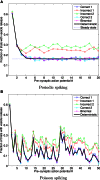Mathematical analysis and algorithms for efficiently and accurately implementing stochastic simulations of short-term synaptic depression and facilitation
- PMID: 23675343
- PMCID: PMC3650633
- DOI: 10.3389/fncom.2013.00058
Mathematical analysis and algorithms for efficiently and accurately implementing stochastic simulations of short-term synaptic depression and facilitation
Abstract
The release of neurotransmitter vesicles after arrival of a pre-synaptic action potential (AP) at cortical synapses is known to be a stochastic process, as is the availability of vesicles for release. These processes are known to also depend on the recent history of AP arrivals, and this can be described in terms of time-varying probabilities of vesicle release. Mathematical models of such synaptic dynamics frequently are based only on the mean number of vesicles released by each pre-synaptic AP, since if it is assumed there are sufficiently many vesicle sites, then variance is small. However, it has been shown recently that variance across sites can be significant for neuron and network dynamics, and this suggests the potential importance of studying short-term plasticity using simulations that do generate trial-to-trial variability. Therefore, in this paper we study several well-known conceptual models for stochastic availability and release. We state explicitly the random variables that these models describe and propose efficient algorithms for accurately implementing stochastic simulations of these random variables in software or hardware. Our results are complemented by mathematical analysis and statement of pseudo-code algorithms.
Keywords: facilitation; short term depression; short term plasticity; short term synaptic dynamics; stochastic simulation; stochastic synapse; synaptic plasticity models; vesicle site model.
Figures






Similar articles
-
Rapid regulation of vesicle priming explains synaptic facilitation despite heterogeneous vesicle:Ca2+ channel distances.Elife. 2020 Feb 20;9:e51032. doi: 10.7554/eLife.51032. Elife. 2020. PMID: 32077852 Free PMC article.
-
The impact of short term synaptic depression and stochastic vesicle dynamics on neuronal variability.J Comput Neurosci. 2013 Aug;35(1):39-53. doi: 10.1007/s10827-012-0438-0. Epub 2013 Jan 26. J Comput Neurosci. 2013. PMID: 23354693 Free PMC article.
-
Mechanisms of target-cell specific short-term plasticity at Schaffer collateral synapses onto interneurones versus pyramidal cells in juvenile rats.J Physiol. 2005 Nov 1;568(Pt 3):815-40. doi: 10.1113/jphysiol.2005.093948. Epub 2005 Aug 18. J Physiol. 2005. PMID: 16109728 Free PMC article.
-
The Small and Dynamic Pre-primed Pool at the Release Site; A Useful Concept to Understand Release Probability and Short-Term Synaptic Plasticity?Front Synaptic Neurosci. 2019 Mar 7;11:7. doi: 10.3389/fnsyn.2019.00007. eCollection 2019. Front Synaptic Neurosci. 2019. PMID: 30899219 Free PMC article. Review.
-
[Short term synaptic plasticity].Rev Neurol. 2002 Mar 16-31;34(6):593-9. Rev Neurol. 2002. PMID: 12040507 Review. Spanish.
Cited by
-
Phase changes in neuronal postsynaptic spiking due to short term plasticity.PLoS Comput Biol. 2017 Sep 22;13(9):e1005634. doi: 10.1371/journal.pcbi.1005634. eCollection 2017 Sep. PLoS Comput Biol. 2017. PMID: 28937977 Free PMC article.
-
Modeling the influence of short term depression in vesicle release and stochastic calcium channel gating on auditory nerve spontaneous firing statistics.Front Comput Neurosci. 2014 Dec 23;8:163. doi: 10.3389/fncom.2014.00163. eCollection 2014. Front Comput Neurosci. 2014. PMID: 25566047 Free PMC article.
References
-
- Abbott L. F., Varela J. A., Sen K., Nelson S. B. (1997). Synaptic depression and cortical gain control. Science 275, 220–224 - PubMed
-
- Carnevale N. T., Hines M. L. (2005). The NEURON Book. New York, NY: Cambridge University Press
LinkOut - more resources
Full Text Sources
Other Literature Sources

